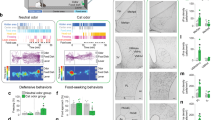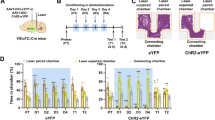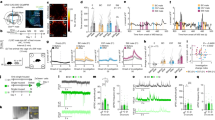Abstract
The neural circuits mediating fear to naturalistic threats are poorly understood. We found that functionally independent populations of neurons in the ventromedial hypothalamus (VMH), a region that has been implicated in feeding, sex and aggression, are essential for predator and social fear in mice. Our results establish a critical role for VMH in fear and have implications for selective intervention in pathological fear in humans.
This is a preview of subscription content, access via your institution
Access options
Subscribe to this journal
Receive 12 print issues and online access
$209.00 per year
only $17.42 per issue
Buy this article
- Purchase on Springer Link
- Instant access to full article PDF
Prices may be subject to local taxes which are calculated during checkout



Similar content being viewed by others
References
Gross, C.T. & Canteras, N.S. Nat. Rev. Neurosci. 13, 651–658 (2012).
Canteras, N.S. Pharmacol. Biochem. Behav. 71, 481–491 (2002).
Motta, S.C. et al. Proc. Natl. Acad. Sci. USA 106, 4870–4875 (2009).
Dhillon, H. et al. Neuron 49, 191–203 (2006).
Lin, D. et al. Nature 470, 221–226 (2011).
Kruk, M.R. et al. Brain Res. 260, 61–79 (1983).
Armbruster, B.N., Li, X., Pausch, M.H., Herlitze, S. & Roth, B.L. Proc. Natl. Acad. Sci. USA 104, 5163–5168 (2007).
Kurrasch, D.M. et al. J. Neurosci. 27, 13624–13634 (2007).
Canteras, N.S., Simerly, R.B. & Swanson, L.W. J. Comp. Neurol. 348, 41–79 (1994).
Alexander, G.M. et al. Neuron 63, 27–39 (2009).
Brandão, M.L., Zanoveli, J.M., Ruiz-Martinez, R.C., Oliveira, L.C. & Landeira-Fernandez, J. Behav. Brain Res. 188, 1–13 (2008).
Wilent, W.B. et al. J. Neurosurg. 112, 1295–1298 (2010).
Berton, O. et al. Science 311, 864–868 (2006).
Ribeiro-Barbosa, E.R., Canteras, N.S., Cezario, A.F., Blanchard, R.J. & Blanchard, D.C. Neurosci. Biobehav. Rev. 29, 1255–1263 (2005).
Langsrud, O. J. Roy. Stat. Soc. D Statistician 51, 305–317 (2002).
Hsu, S.M. & Raine, L. J. Histochem. Cytochem. 29, 1349–1353 (1981).
Hancock, J.F., Cadwallader, K., Paterson, H. & Marshall, C.J. EMBO J. 10, 4033–4039 (1991).
Szymczak, A.L. et al. Nat. Biotechnol. 22, 589–594 (2004).
Pilpel, N., Landeck, N., Klugmann, M., Seeburg, P.H. & Schwarz, M.K. J. Neurosci. Methods 182, 55–63 (2009).
Knobloch, H.S. et al. Neuron 73, 553–566 (2012).
Franklin, K.B.J. & Paxinos, G. The Mouse Brain in Stereotaxic Coordinates (Academic Press, San Diego, 1997).
Acknowledgements
We thank F. Zonfrillo, R. Migliozzi, E. Audero, P. Hublitz, L. Carbonari, E. Amendola, B. Klaus and the EMBL Transgenic Facility and Mechanical Workshop for experimental support, M. Yang and S. Motta for critical advice, and R. Sotillo and M. Jechlinger (Mouse Biology Unit, EMBL) for antibodies. This work was supported by funds from the US National Institutes of Health (MH093887-01) to C.T.G., from the EMBL to C.T.G., B.A.S., C.M. and P.K., and from the German Research Foundation (DFG, GR 3619/2-1, 3619/3-1, GR 3619/4-1) and Chica and Heinz Schaller Research Foundation to V.G.
Author information
Authors and Affiliations
Contributions
B.A.S. designed, carried out and analyzed all of the experiments, except for some of the behavioral experiments, which were carried out and analyzed by C.M. and P.K., and the electrophysiology experiments, which were designed, carried out and analyzed by E.M. and D.R. Viruses were produced and tested by A.I. and V.G. The project was conceived by B.A.S. and C.T.G. with critical input from N.S.C. The manuscript was written by B.A.S. and C.T.G. with input from D.R. and N.S.C.
Corresponding author
Ethics declarations
Competing interests
The authors declare no competing financial interests.
Integrated supplementary information
Supplementary Figure 1 (related to Figure 1a-d). Flight behavior elicited in mice by different classes of threat.
(a) The number of flight behaviors performed during the poststimulus (Stimulus) free exploration period were significantly increased after predator, aggressive conspecific, and foot shock, but not toy rat exposure when compared to the prestimulus habituation (Habituation) session. Re-exposure to the context (Context) elicited an increase in flights to predator and foot shock, but not aggressive conspecific or toy rat (Predator: N = 15, Social: N = 9, Foot shock: N = 6, Fake rat: N = 6, * P < 0.05, *** P < 0.001).
Supplementary Figure 2 (related to Fig. 2a-d). TomatoF expression in Nr5a1::hM4D-2A-tomatoF transgenic mice (rostral part).
Farnesylated tomato (tom-f, see Fig. 2a) expression was found in cell bodies in the VMHdm and in projections in a number of previously reported target brain regions [10]. Fluorescent images of rostral to caudal coronal brain sections from Nr5a1::hM4D-2A-tomatoF transgenic mice are shown overlaid with the outlines of mouse brain structures deriving from a standard anatomical atlas [22]. Atlas outlines were morphed in some cases to better match the sections.
Supplementary Figure 3 (related to Fig. 2a-d). TomatoF expression in Nr5a1::hM4D-2A-tomatoF transgenic mice (caudal part).
Farnesylated tomato (tom-f, see Fig. 2a) expression was found in cell bodies in the VMHdm and in projections in a number of previously reported target brain regions [10]. Fluorescent images of rostral to caudal coronal brain sections from Nr5a1::hM4D-2A-tomatoF transgenic mice are shown overlaid with the outlines of mouse brain structures deriving from a standard anatomical atlas [22]. Atlas outlines were morphed in some cases to better match the sections.
Supplementary Figure 4 (related to Fig. 2f). HA-hM4D is selectively expressed in VMHdm of Nr5a1::hM4D-2A-tomatoF mice.
(a) Immunofluorecence with anti-HA antibodies in coronal brain sections of Nr5a1::hM4D-2A-tomatoF transgenic mice revealed robust expression of HA-hM4D in the dorsal-medial and central portions of VMH. No detectable anti-HA staining was seen outside VMH.
Supplementary Figure 5 (related to Fig. 3e-f). Extent of infection and its correlation with defensive behavior in mice locally injected with AAV-Syn::Venus-2A-hM4D in VMHvl.
(a, c, e) Diagrams and (b, d, f) quantitative graphs of the extent of infection as estimated by Venus reporter gene expression in individuals from three groups (ab, cd, ef) of mice injected locally with AAV-Syn::Venus-2A-hM4D in the VMHvl and treated with CNO. Diagrams show the color-coded extent of infection superimposed on a coronal brain section from a standard atlas [22] (Bregma -1.82). Graphs show the total area of bilateral infection in posterior VMHvl (color-coding matches diagrams) plotted against the defensive behavior displayed by CNO treated animals in response to exposure to an aggressive conspecific.
Supplementary Figure 6 (related to Fig. 3d-e). Correlation of extent of infection in different hypothalamic areas and defensive behaviors in mice locally injected with AAVSyn:: Venus-2A-hM4D in VMHvl.
Extent of infection (total bilateral area) in (a) VMHvl, (b) VMHdm, (c) lateral hypothalamus (LH), and (d) tuberal nucleus plotted against the amount of defensive behaviors displayed by CNO treated animals in response to exposure to an aggressive conspecific. Correlation between the extent of infection and defensive behavior was calculated by MANCOVA (P = 0.032) followed by pairwise correlations with VMHvl (Pearson's r = – 0.708, P < 0.01), VMHdm (Pearson's r = – 0.524, P > 0.05), LH (Pearson's r = – 0.482, P > 0.05), and tuberal (Pearson's r = – 0.315, P > 0.05) nuclei. For the statistical analysis outliers (reported in lighter grey) showing poor infection (< 20,000 μm2 total infection, N = 3) or behavior (> 1.5 x IQR above third quartile, N = 2) were excluded. (e) A significantly lower extent of infection was seen in VMHdm compared to VMHvl in these animals (N =19, * P < 0.05). (f) Scheme of the areas used for quantification of each region. Rectangular areas were matched on nuclei from a standard atlas [22]. For quantification in the tuberal nucleus we considered the area located in the base of the tuberal region of the hypothalamus, just laterally to the VMHvl as described by [10].
Supplementary Figure 7 (related to Fig. 3d-f). Attacks received and submissive behavior were not affected by pharmacogenetic inhibition of VMHvl.
Number of (b) upright postures or (a) biting attacks received by the experimental mouse infected in VMHvl with AAVSyn:: Venus-2A-hM4D during the encounter with the aggressive stimulus mouse was not altered by CNO treatment when compared to vehicle treated control mice (VMHvl: N = 17-19, P > 0.05).
Supplementary Figure 8 (related to Fig. 3g-h). Extent of infection and its correlation with defensive behavior in mice locally injected with AAV-Syn::Venus-2A-hM4D in dPAG.
(a, c, e) Diagrams and (b, d, f) quantitative graphs of the extent of infection as estimated by Venus reporter gene expression in mice injected locally with AAV-Syn::Venus-2A-hM4D in the dPAG and treated with CNO. Diagrams show the color-coded extent of infection superimposed on a coronal brain section from a standard atlas [22] (Bregma -4.36). Graphs show the average percentage of bilateral infection in dPAG (color-coding matches diagrams) plotted against the defensive behavior displayed by CNO-treated animals in response to exposure to an aggressive conspecific (ab, Social; cd, Foot shock; ef, predator).
Supplementary Figure 9 (related to Fig. 3g-h). Mice injected with AAV-Syn::Venus-2AhM4D in superior colliculus (SC) and treated with CNO do not show decreased defensive behavior to a predatory rat.
(a) CNO-treated mice locally injected with AAVSyn:: Venus-2A-hM4D in dPAG (N = 13, P < 0.05), but not SC (N = 4, P > 0.05) showed a decrease in defensive behaviors to a predatory rat compared to similarly infected vehicle treated mice (N = 5). (b) Diagram showing the extent of infection superimposed on a coronal brain section from a standard atlas [22] (Bregma -4.36) in individual CNO-treated mice injected with AAV-Syn::Venus-2A-hM4D in SC.
Supplementary Figure 10 (related to Fig. 3g-h). Attacks received and submissive behaviors following pharmacogenetic inhibition of dPAG.
CNO treatment did not change the (a) number of attacks received by mice infected in dPAG with AAV-Syn::Venus-2A-hM4D. (b) Time spent in upright postures during the encounter with the aggressive stimulus mouse was decreased by CNO treatment when compared to vehicle treated control mice (N = 9-10).
Supplementary information
Supplementary Text and Figures
Supplementary Figures 1–10 (PDF 9425 kb)
Rights and permissions
About this article
Cite this article
Silva, B., Mattucci, C., Krzywkowski, P. et al. Independent hypothalamic circuits for social and predator fear. Nat Neurosci 16, 1731–1733 (2013). https://doi.org/10.1038/nn.3573
Received:
Accepted:
Published:
Issue Date:
DOI: https://doi.org/10.1038/nn.3573
This article is cited by
-
A dedicated hypothalamic oxytocin circuit controls aversive social learning
Nature (2024)
-
Detection of neuronal defensive discharge information transmission and characteristics in periaqueductal gray double-subregions using PtNP/PEDOT:PSS modified microelectrode arrays
Microsystems & Nanoengineering (2023)
-
A sex-specific thermogenic neurocircuit induced by predator smell recruiting cholecystokinin neurons in the dorsomedial hypothalamus
Nature Communications (2023)
-
Brain Mechanisms Underlying Panic Attack and Panic Disorder
Neuroscience Bulletin (2023)
-
Male and female mice display consistent lifelong ability to address potential life-threatening cues using different post-threat coping strategies
BMC Biology (2022)



